1996 CHEVROLET CAVALIER key battery
[x] Cancel search: key batteryPage 34 of 372

Downloaded from www.Manualslib.com manuals search engine 0
,e
Your vehicle is equipped with a crash sensing
and diagnostic module, which records information
about the
air bag system. The module records
information about the readiness
of the system, when
the sensors are activated and driver’s safety belt
usage at deployment.
Let
only qualified technicians work on your
air bag system. Improper service can mean that
your
air bag system won’t work properly. See your
dealer for service.
Servicing Your Air Bag-Equipped
Chevrolet
Air bags affect how your Chevrolet should be serviced.
There are
parts of the air bag system in several places
around your vehicle. You don’t want
the system to
inflate while someone is working
on your vehicle. Your
Chevrolet dealer and the Cavalier Service Manual have
information about servicing your vehicle and
the air bag
system.
To purchase a service manual, see “Service and
Owner Publications”
in the Index.
NOTICE:
If you damage the cover for the’ driver’s or the
right front passenger’s
air bag, they may not
work properly. You may have to replace the
air
bag module in the steering wheel or both the air
bag module and the instrument panel for the
right front passenger’s
air bag. Do not open or
break the
air bag covers.
I
For up to 10 minutes after the ignition key is
turned off and the battery is disconnected, an air
bag can still inflate during improper service. You
can be injured
if you are close to an air bag when
it inflates. Avoid wires wrapped with yellow tape
or yellow connectors. They are probably part of
the
air bag system. Be sure to follow proper
service procedures, and make sure the person
performing work for you
is qualified to do so.
The air bag system does not need regular maintenance.
Page 63 of 372

Downloaded from www.Manualslib.com manuals search engine the rear door from the inside. You should let adults and
older children know how
to cancel the locks.
To cancel the rear door lock:
1. Unlock the door from the inside and open the door
from the outside.
2. Use a key to move the lock all the way down.
3. Do the same for the other rear door.
The rear door locks will now work normally.
Leaving Your Vehicle
If you are leaving the vehicle, open your door and set
the locks from inside. Then get out and close the door.
Keyless Entry System (Option)
If your Chevrolet has this option, you can lock and
unlock your doors or unlock your trunk from up
to
30 feet (9 m) away using the key chain transmitter
supplied with your vehicle. Your Keyless Entry
System operates on
a
radio frequency subject to
Federal Communications
Commission (FCC) Rules.
This device complies with Part 15 of the FCC Rules.
Operation is subject to the following two conditions:
(1) This device may not cause harmful interference,
and
(2) This device must accept any interference
received, including interference that may cause
undesired operation.
Should interference
to this system occur, try this:
Check to determine if battery replacement is
necessary. See the instructions on battery
replacement.
Check the distance. You may be too far from your
vehicle.
This product has a maximum range.
2-5
Page 64 of 372

Downloaded from www.Manualslib.com manuals search engine 0 Check the location. Other vehicles or objects may be
See your Chevrolet dealer or a qualified technician
blocking
the signal.
for service.
Changes
or modifications to this system by other than an
authorized service facility could void authorization to
use this equipment.
Operation
The driver’s door will unlock automatically when
UNLOCK is pressed.
If pressed again within five
seconds, all the doors will unlock. All doors will lock
when DOOR
is pressed.
The trunk will unlock anytime when the opened trunk
symbol on the Keyless Entry Control is pressed and
the ignition key is
OFF. On vehicles equipped with a
manual transaxle, the parking brake must be set.
Press DOOR or
UNLOCK to illuminate the interior
lamps. The lamps will then
go off after 40 seconds
when
UNLOCK is pressed and for a few seconds when
DOOR is pressed. When the ignition is turned on, the
lamps will also fade out. See “Illuminated Entry”
in
the Index.
Matching Tkansmitter(s) To Your Vehicle
Each key chain transmitter is coded to prevent another
transmitter from unlocking your vehicle. If a transmitter
is lost or stolen, a replacement can be purchased
through your dealer. Remember to bring
any remaining
transmitters with you when you
go to your dealer.
When the dealer matches the replacement transmitter
to
your vehicle, any remaining transmitters must also be
matched. Once the new transmitter is coded, the lost
transmitter will not unlock your vehicle. Each vehicle
can have only two transmitters matched to it.
Battery Replacement
Under normal use, the batteries in your key chain
transmitter should last about two years.
You can tell the batteries are weak if the transmitter
won’t work at the normal range in any location. If you
have to get close to your,vehicle before the transmitter
works, it’s probably time to change the batteries.
Page 70 of 372
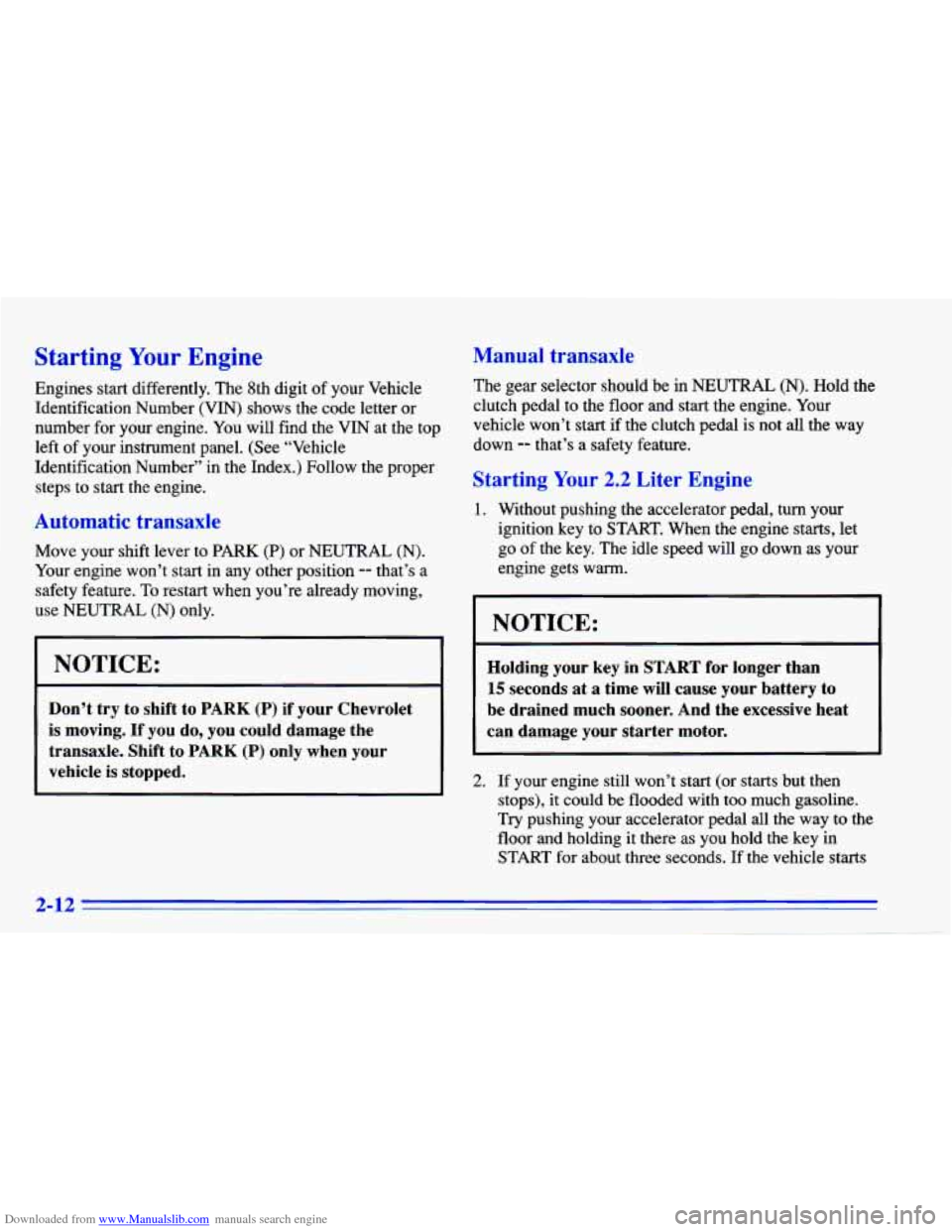
Downloaded from www.Manualslib.com manuals search engine Starting Your Engine
Engines start differently. The 8th digit of your Vehicle
Identification Number (VIN) shows the code letter or
number for your engine. You will find the VIN at the top
left of your instrument panel. (See “Vehicle
Identification Number” in the Index.) Follow the proper
steps to start the engine.
Automatic transaxle
Move your shift lever to PARK (P) or NEUTRAL (N).
Your engine won’t start in any other position -- that’s a
safety feature.
To restart when you’re already moving,
use
NEUTRAL (N) only.
NOTICE:
Don’t try to shift to PARK (P) if your Chevrolet
is moving.
If you do, you could damage the
transaxle. Shift to PARK
(P) only when your
vehicle is stopped.
Manual transaxle
The gear selector should be in NEUTRAL (N). Hold the
clutch pedal to the floor and start the engine. Your
vehicle won’t start if the clutch pedal is not all
the way
down
-- that’s a safety feature.
Starting Your 2.2 Liter Engine
1. Without pushing the accelerator pedal, turn your
ignition key to START. When the engine starts, let
go
of the key. The idle speed will go down as your
engine gets warm.
I NOTICE:
r
Holding your key in START for longer than
15 seconds at a time will cause your battery to
be drained much sooner. And the excessive heat
can damage your starter motor.
2. If your engine still won’t start (or starts but then
stops), it could be flooded with too much gasoline.
Try pushing your accelerator pedal all the way to the
floor and holding it there as you hold
the key in
START for about three seconds. If the vehicle starts
2-12
Page 71 of 372
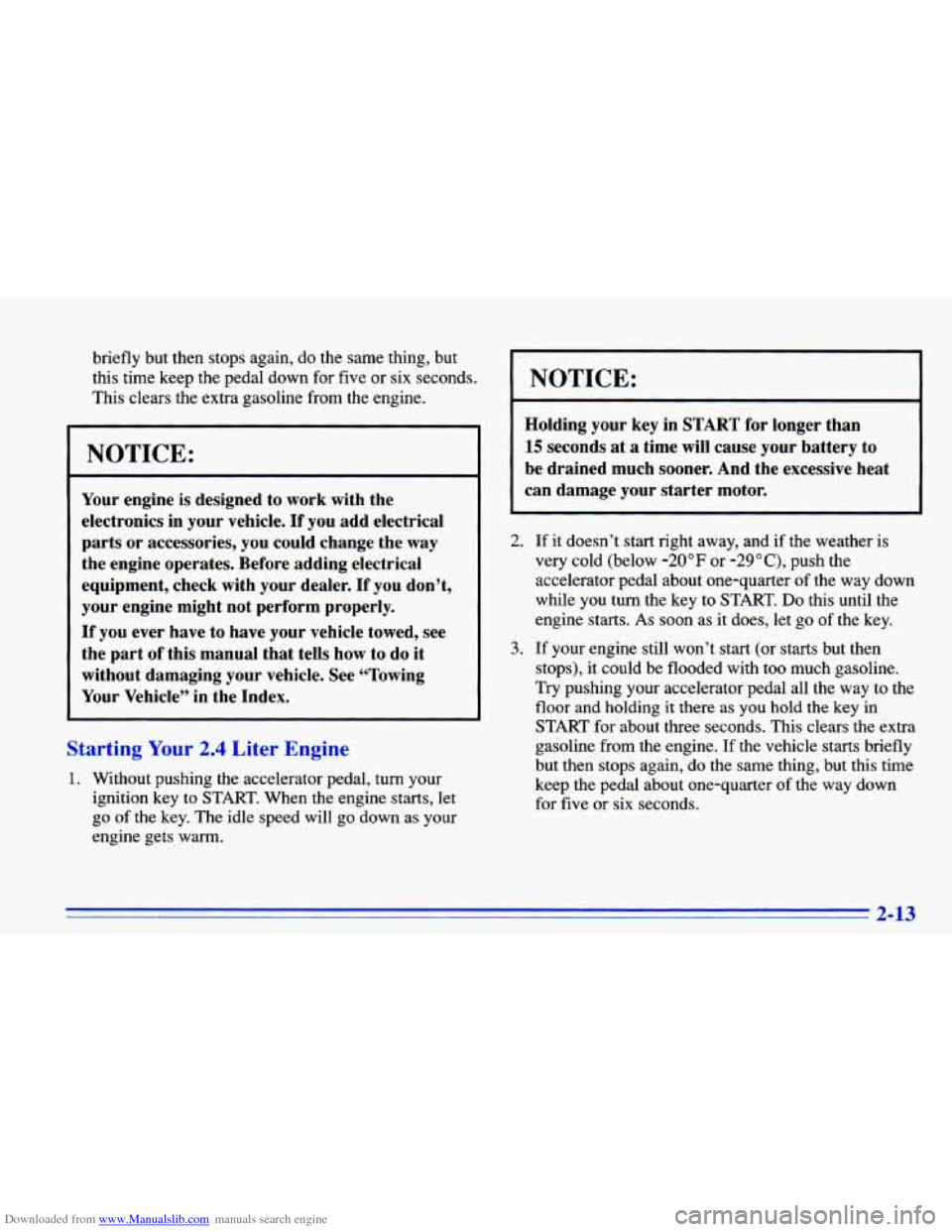
Downloaded from www.Manualslib.com manuals search engine briefly but then stops again, do the same thing, but
this time keep the pedal down for five or six seconds.
This clears the extra gasoline from the engine.
NOTICE:
Your engine is designed to work with the
electronics in your vehicle.
If you add electrical
parts or accessories, you could change the way
the engine operates. Before adding electrical
equipment, check with your dealer.
If you don’t,
your engine might not perform properly.
If you ever have to have your vehicle towed, see
the part of this manual
that tells how to do it
without damaging your vehicle, See “Towing
Your Vehicle” in the Index.
Starting Your 2.4 Liter Engine
1. Without pushing the accelerator pedal, turn your
ignition key to START. When the engine starts, let
go of the key. The idle speed will go down as your
engine gets warm.
I NOTICE:
Holding your key in START for longer than
15 seconds at a time will cause your battery to
be drained much sooner. And the excessive heat
can damage your starter motor.
2.
3.
If it doesn’t start right away, and if the weather is
very cold (below
-20°F or -29”C), push the
accelerator pedal about one-quarter of the way down
while you turn the key to START.
Do this until the
engine starts.
As soon as it does, let go of the key.
If your engine still won’t start (or starts but then
stops), it could be flooded with too much gasoline.
Try pushing your accelerator pedal all the way to the
floor and holding it there as
you hold the key in
START for about three seconds. This clears the extra
gasoline from the engine. If the vehicle starts briefly
but then stops again, do the same thing, but this time
keep the pedal about one-quarter
of the way down
for five
or six seconds.
2-13
Page 191 of 372
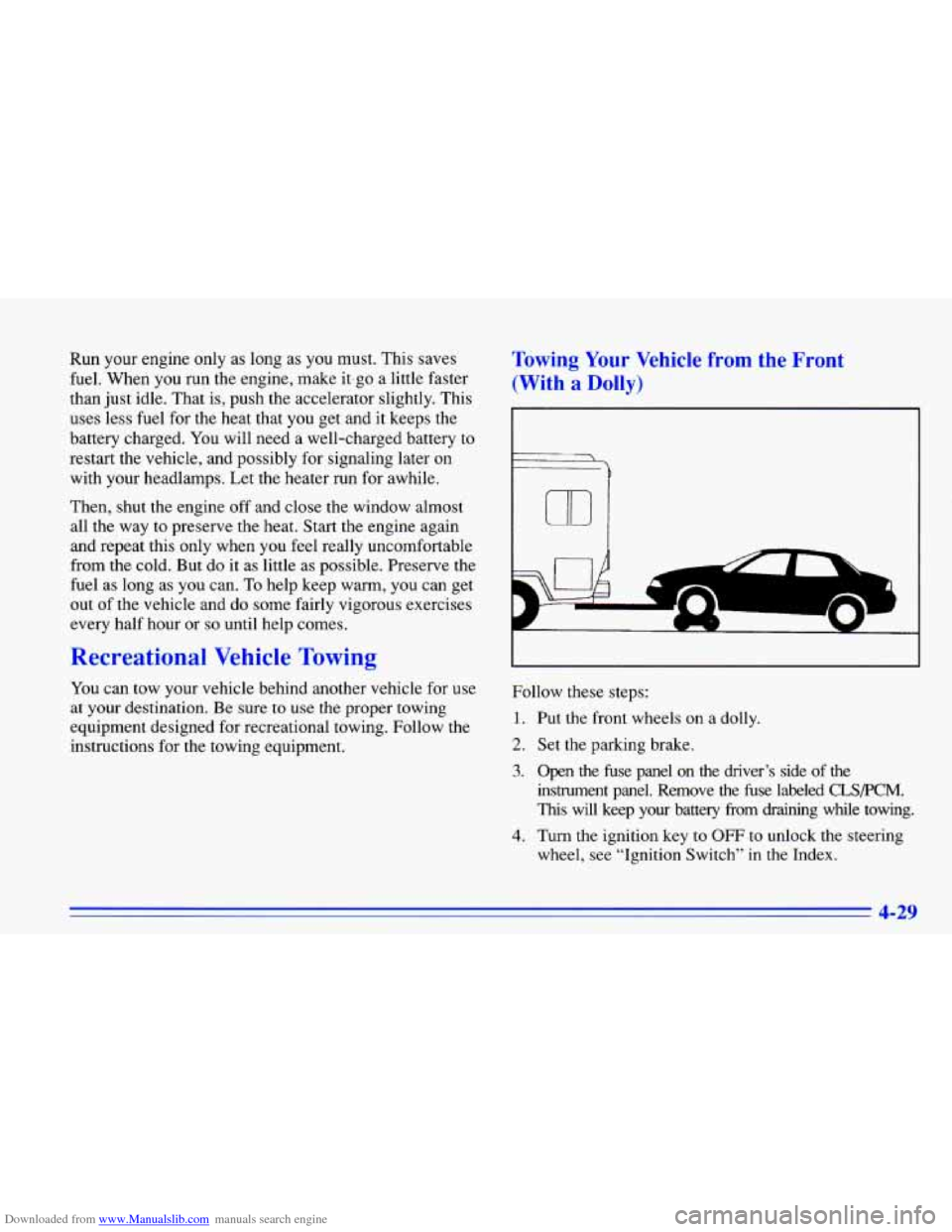
Downloaded from www.Manualslib.com manuals search engine Run your engine only as long as you must. This saves
fuel. When you run the engine, make it.go a little faster
than just idle. That is, push the accelerator slightly. This
uses less fuel for the heat that you get and it keeps the
battery charged.
You will need a well-charged battery to
restart the vehicle, and possibly for signaling later
on
with your headlamps. Let the heater run for awhile.
Then, shut the engine off and close the window almost
all the way
to preserve the heat. Start the engine again
and repeat this only when you feel really uncomfortable
from the cold. But do it as little as possible. Preserve the
fuel as long as you can.
To help keep warm, you can get
out of the vehicle and do some fairly vigorous exercises
every half hour or
so until help comes.
Recreational Vehicle Towing
You can tow your vehicle behind another vehicle for use
at your destination. Be sure
to use the proper towing
equipment designed for recreational towing. Follow the
instructions for the towing equipment.
Towing Your Vehicle from the Front
(With a Dolly)
€
7
m
Follow these steps:
1. Put the front wheels on a dolly.
2. Set the parking brake.
3. Open the fuse panel on the driver’s side of the
instrument panel. Remove the fuse labeled
CLSPCM.
This will keep your battery from draining while towing.
4. Turn the ignition key to OFF to unlock the steering
wheel, see “Ignition Switch’’ in the Index.
4-29
Page 192 of 372
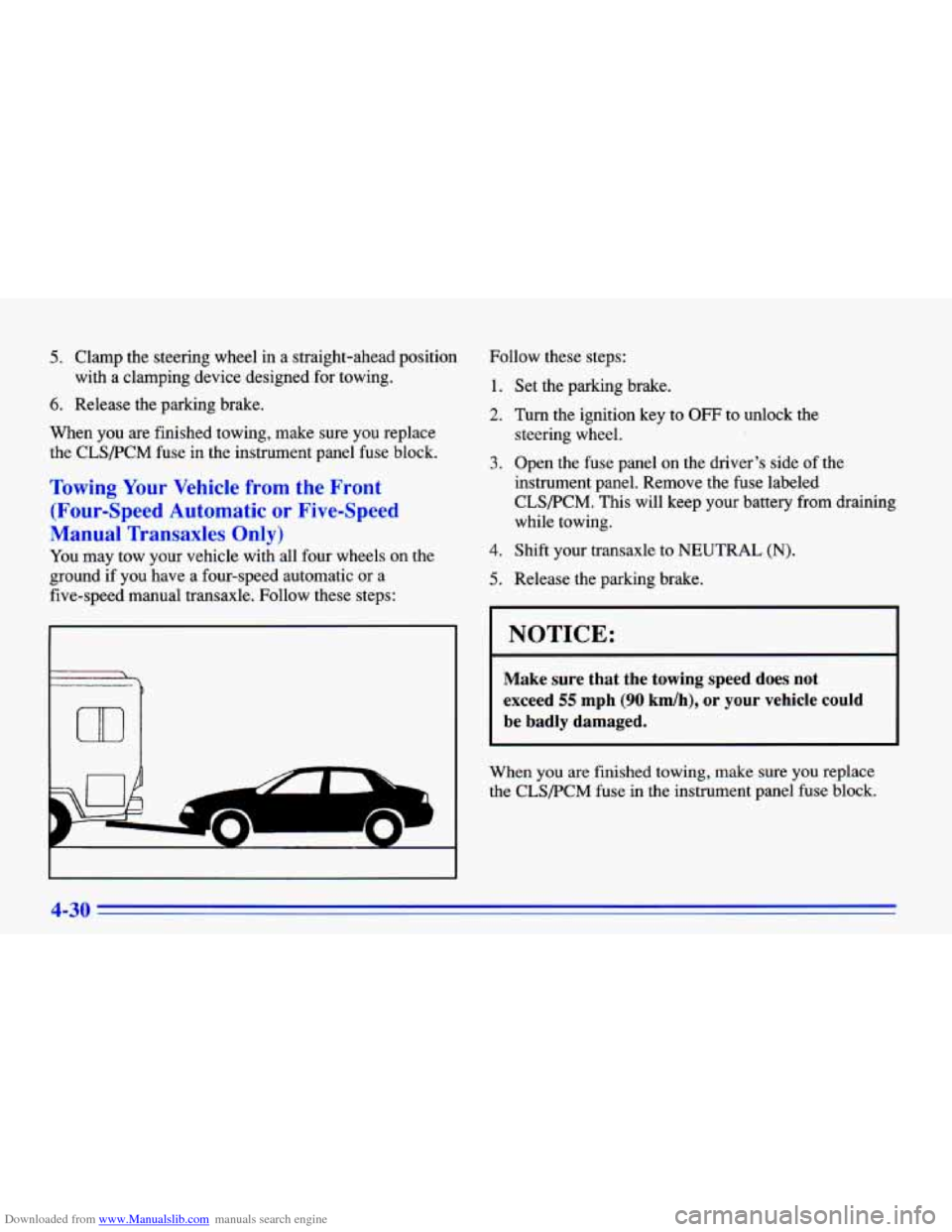
Downloaded from www.Manualslib.com manuals search engine 5. Clamp the steering wheel in a straight-ahead position
6. Release the parking brake.
When you
are finished towing, make sure you replace
the CLS/PCM fuse in the instrument panel fuse block.
with a clamping device designed for towing.
Towing Your Vehicle from the Front
(Four-Speed Automatic
or Five-Speed
Manual Transaxles Only)
You may tow your vehicle with all four wneels on the
ground
if you have a four-speed automatic or a
five-speed manual transaxle. Follow these steps:
r
m
.
*-
Follow these steps:
1. Set the parking brake.
2. Turn the ignition key to OFF to unlock the
3. Open the fuse panel on the driver’s side of the
instrument panel. Remove the fuse labeled
CLS/PCM. This will keep your battery from draining
while towing. steering wheel.
4. Shift your transaxle to NEUTRAL (N).
5. Release the parking brake.
NOTICE:
Make sure that the towing speed does not
exceed
55 mph (90 km/h), or your vehicle could
be badly damaged.
When you are finished towing, make sure you replace
the CLS/PCM fuse in the instrument panel fuse block.
4-30
Page 359 of 372
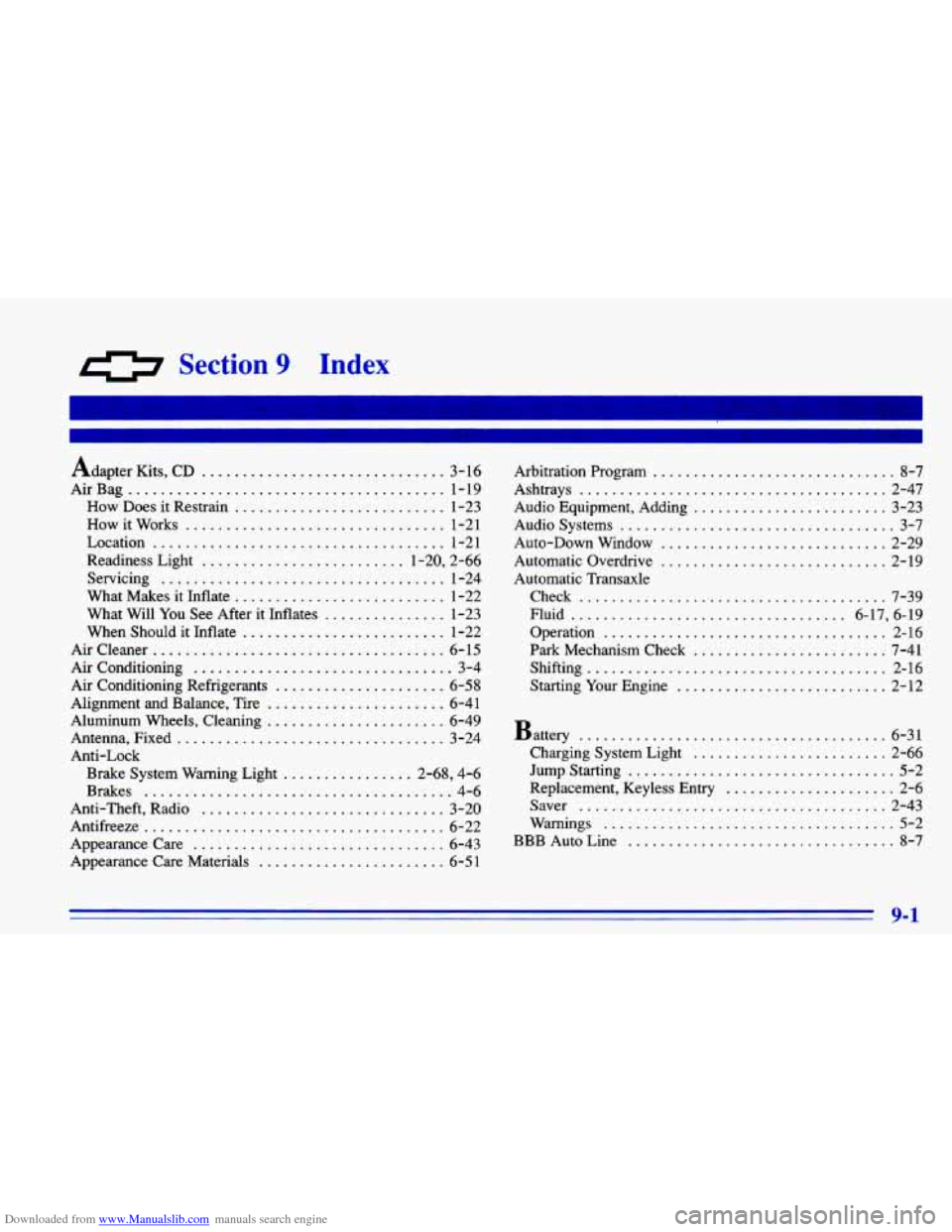
Downloaded from www.Manualslib.com manuals search engine 0 Section 9 Index
Adapter Kits. CD .............................. 3-16
AirBag
....................................... 1-19
How Does it Restrain
.......................... 1-23
How it Works
................................ 1-21
Location
.................................... 1-21
Readiness Light
......................... 1.20. 2.66
Servicing
................................... 1-24
What Makes
it Inflate .......................... 1-22
What Will You See After it Inflates
............... 1-23
When Should
it Inflate ......................... 1-22
Air Cleaner
.................................... 6- 15
Air Conditioning
................................ 3-4
Alignment and Balance. Tire
...................... 6-41
Aluminum Wheels. Cleaning
...................... 6-49
Antenna. Fixed
................................. 3-24
Anti-Lock Brake System Warning Light
................ 2.68. 4.6
Brakes
...................................... 4-6
Anti.Theft. Radio
.............................. 3-20
Antifreeze
..................................... 6-22
Appearance Care Materials
....................... 6-5 1
Air Conditioning Refrigerants ..................... 6-58
Appearancecare
............................... 6-43
Arbitration Program .............................. 8-7
Audio Equipment. Adding
........................ 3-23
Audio Systems
.................................. 3-7
Auto-Down Window
............................ 2-29
Automatic Overdrive
............................ 2-19
Automatic Transaxle Check
...................................... 7-39
Fluid
.................................. 6.17. 6.19
Operation
................................... 2-16
Park Mechanism Check
........................ 7-41
Shifting
..................................... 2-16
Startine Your Engine
.......................... 2-12
Ashtrays
...................................... 2-47
Battery
...................................... 6.3 1
Charging System Light ........................ 2-66
Jump Starting
................................. 5-2
Replacement. Keyless Entry
..................... 2-6
Saver
...................................... 2-43
Warnings
.................................... 5-2
BBB Auto Line
................................. 8-7
9-1